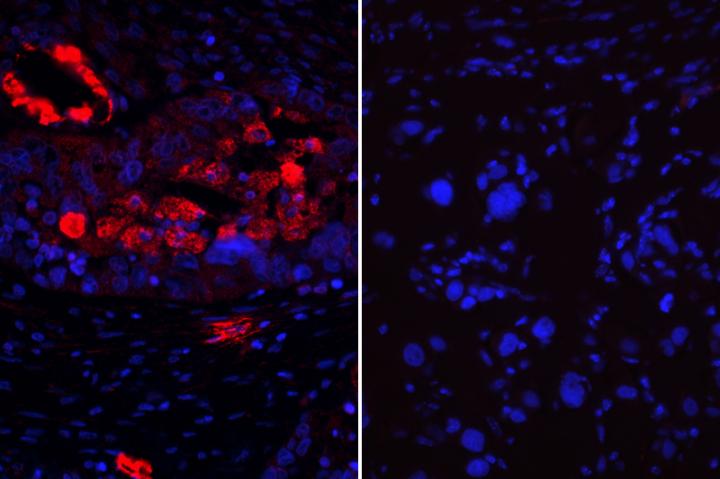Combination therapy could provide new treatment option for ovarian cancer

Ovarian cancer tumors with higher percentages of cIAP-expressing cells, shown in red at left, were more sensitive to a potential combination therapy than tumor cells without cIAP-expressing cells. Credit: UCLA Broad Stem Cell Research Center
Preclinical research from Dr. Sanaz Memarzadeh, who is a member of the Eli and Edythe Broad Center of Regenerative Medicine and Stem Cell Research at UCLA, has potentially solved this mystery and pinpointed a combination therapy that may be effective for up to 50 percent of women with ovarian cancer.
Memarzadeh's research, published in the journal Precision Oncology, shows a new combination therapy of carboplatin and an experimental drug called birinapant can improve survival in mice with ovarian cancer tumors. Additional findings reveal that testing for a specific protein could identify ovarian tumors for which the treatment could be effective. Importantly, the treatment could also target cancers that affect other parts of the body, including the bladder, cervix, colon and lung cancer.
In 2015, Memarzadeh and her team uncovered and isolated carboplatin-resistant ovarian cancer stem cells. These cells have high levels of proteins called cIAPs, which prevent cell death after chemotherapy.
Since the cancer stem cells survive carboplatin treatment, they regenerate the tumor; with each recurrence of ovarian cancer, treatment options become more limited. Memarzadeh showed that birinapant, which degrades cIAPs, can make carboplatin more effective against some ovarian cancer tumors.
“I've been treating women with ovarian cancer for about two decades and have seen firsthand that ovarian cancer treatment options are not always as effective as they should be,” said Memarzadeh, director of the G.O. Discovery Lab and member of the UCLA Jonsson Comprehensive Cancer Center. “Our previous research was promising, but we still had questions about what percentage of tumors could be targeted with the birinapant and carboplatin combination therapy, and whether this combination could improve overall survival by eradicating chemotherapy-resistant ovarian cancer tumors.”
In this new study, the research team first tested whether the combination therapy could improve survival in mice. Half of the mice tested had carboplatin-resistant human ovarian cancer tumors and the other half had carboplatin-sensitive tumors.
The team administered birinapant or carboplatin as well as the two drugs combined and then monitored the mice over time. While birinapant or carboplatin alone had minimal effect, the combination therapy doubled overall survival in half of the mice regardless of whether they had carboplatin-resistant or carboplatin-sensitive tumors.
“Our results suggest that the treatment is applicable in some, but not all, tumors,” said Rachel Fujikawa, a fourth year undergraduate student in Memarzadeh's lab and co-first author of the study.
To assess the combination therapy's rate of effectiveness in tumors, the team went on to test 23 high-grade serous ovarian cancer tumors from independent patients. Some were from patients who had never been treated with carboplatin and some were from patients who had carboplatin-resistant cancer.
With these samples, the researchers generated ovarian cancer tumors utilizing a method called disease-in-a-dish modeling and tested the same treatments previously tested in mice. Once again, carboplatin or birinapant alone had some effect, while the combination of birinapant and carboplatin successfully eliminated the ovarian cancer tumors in approximately 50 percent of samples. Importantly, the combination therapy worked for both carboplatin-resistant and carboplatin-sensitive tumors.
The researchers also measured cIAPs (the target for the drug birinapant) in the tumors. They found a strong correlation between cancer stem cells with high levels of cIAP and a positive response to the combination therapy. Since elevated levels of cIAPs have been linked to chemotherapy resistance in other cancers, the researchers wondered if the combination therapy could effectively target those cancers as well.
The team created disease-in-a-dish models using human bladder, cervix, colon and lung cancer cells and tested the combination therapy. Similar to the ovarian cancer findings, 50 percent of the tumors were effectively targeted and high cIAP levels correlated with a positive response to the combination therapy.
“I believe that our research potentially points to a new treatment option. In the near future, I hope to initiate a phase 1/2 clinical trial for women with ovarian cancer tumors predicted to benefit from this combination therapy,” said Memarzadeh, gynecologic oncology surgeon and professor at the David Geffen School of Medicine at UCLA.
###
The research was supported by an American Cancer Society Research Scholar Grant (RSG-14-217-407 01-TBG), the Phase One Foundation, the Ovarian Cancer Circle Inspired by Robin Babbini, a STOP Cancer Margot Lansing Memorial Seed award, the National Institutes of Health (R01CA183877 and #U54 MD007598) and the UCLA Broad Stem Cell Research Center.
Media Contact
All latest news from the category: Health and Medicine
This subject area encompasses research and studies in the field of human medicine.
Among the wide-ranging list of topics covered here are anesthesiology, anatomy, surgery, human genetics, hygiene and environmental medicine, internal medicine, neurology, pharmacology, physiology, urology and dental medicine.
Newest articles

First-of-its-kind study uses remote sensing to monitor plastic debris in rivers and lakes
Remote sensing creates a cost-effective solution to monitoring plastic pollution. A first-of-its-kind study from researchers at the University of Minnesota Twin Cities shows how remote sensing can help monitor and…

Laser-based artificial neuron mimics nerve cell functions at lightning speed
With a processing speed a billion times faster than nature, chip-based laser neuron could help advance AI tasks such as pattern recognition and sequence prediction. Researchers have developed a laser-based…

Optimising the processing of plastic waste
Just one look in the yellow bin reveals a colourful jumble of different types of plastic. However, the purer and more uniform plastic waste is, the easier it is to…



